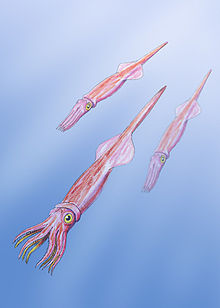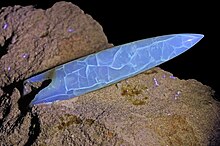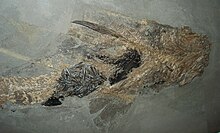fr
noms dans le fil d’Ariane


Belemnoids are an extinct group of marine cephalopod, very similar in many ways to the modern squid and closely related[1] to the modern cuttlefish. Like them, the belemnoids possessed an ink sac,[2] but, unlike the squid, they possessed ten arms of roughly equal length, and no tentacles.[3] The name "belemnoid" comes from the Greek word βέλεμνον, belemnon meaning "a dart or arrow" and the Greek word είδος, eidos meaning "form".[4]
Belemnoids include belemnites (which belong to order Belemnitida proper), aulacocerids (order Aulacocerida), phragmoteuthids (order Phragmoteuthida), and diplobelids (order Diplobelida).
Belemnoids were numerous during the Jurassic and Cretaceous periods, and their fossils are abundant in Mesozoic marine rocks, often accompanying their cousins the ammonites. The belemnoids become extinct at the end of the Cretaceous period along with the ammonites. The belemnoids' origin lies within the bactritoid nautiloids, which date from the Devonian period; well-formed belemnoid guards can be found in rocks dating from the Mississippian (or Early Carboniferous) onward through the Cretaceous. Other fossil cephalopods include baculites, nautiloids and goniatites.
Belemnoids possessed a central phragmocone made of aragonite and with negative buoyancy.[5] To the rear of the creature was a heavy calcite guard whose main role appears to have been to counterbalance the front (towards the head) of the organism; it positions the centre of mass below the centre of buoyancy, increasing the stability of the swimming organism.[5] The guard would account for between a third and a fifth of the length of the complete organism, arms included.[5]
Like some modern squid, belemnoid arms carried a series of small hooks for grabbing prey. Belemnoids were efficient carnivores that caught small fish and other marine animals with their arms and ate them with their beak-like jaws. In turn, belemnites appear to have formed part of the diet of marine reptiles such as Ichthyosaurs, whose fossilized stomachs frequently contain phosphatic hooks from the arms of cephalopods.
Belemnoids were effectively neutrally buoyant, and swam in near-shore to mid-shelf oceans.[5] Their fins could be used to their advantage in all water speeds; in a gentle current they could be flapped for propulsion; in a stronger current they could be held erect to generate lift; and when swimming rapidly by jet propulsion they could be tucked in to the body for streamlining.[5]


Normally with fossil belemnoids only the back part of the shell (called the guard or rostrum) is found. The guard is usually elongated and bullet-shaped (though in some subgroups the rostrum may only exist as a thin layer coating the phragmocone). The hollow region at the front of the guard is termed the alveolus, and this houses a chambered conical-shaped part of the shell (called the phragmocone). The phragmocone is usually only found with the better preserved specimens. Projecting forwards from one side of the phragmocone is the thin pro-ostracum.
While belemnoid phragmocones are homologous with the shells of other cephalopods and are similarly composed of aragonite, belemnoid guards are evolutionarily novel and are composed of calcite or aragonite, thus tending to preserve well. Broken guards show a structure of radiating calcite fibers and may also display concentric growth rings.
Diagenetic modifications of the shells are complex.[6][7] Radiating calcitic crystals are thin, or very large, with a shape indicative of a strong alteration.[8][9] In other samples, the aragonite - calcite boundary is not dependent on growth lines.[10] In a given fossil sites, some specimens are calcite, others are aragonite.
The guard, phragmocone and pro-ostracum were all internal to the living creature, forming a skeleton which was enclosed entirely by soft muscular tissue. The original living creature would have been larger than the fossilized shell, with a long streamlined body and prominent eyes. The guard would have been in place toward the rear of the creature, with the phragmocone behind the head and the pointed end of the guard facing backward.
The guard of the belemnoid Megateuthis gigantea, which is found in Europe and Asia, can measure up to 46 centimetres (18 in) in length, giving the living animal an estimated length of 3 metres (10 ft).
Very exceptional belemnoid specimens have been found showing the preserved soft parts of the animal. Elsewhere in the fossil record, bullet-shaped belemnite guards are locally found in such profusion that such deposits are referred to semi-formally as "belemnite battlefields" (cf. "orthocone orgies"). It remains unclear whether these deposits represent post-mating mass death events, as are common among modern cephalopods and other semelparous creatures.
The name "thunderbolt" or "thunderstone" has also been traditionally applied to the fossilised rostra of belemnoids. The origin of these bullet-shaped stones was not understood, and thus a mythological explanation of stones created where lightning struck has arisen.[11]
The stable isotope composition of a belemnoid rostrum from the Peedee Formation (Cretaceous, southeast USA) has long been used as a global standard (Peedee Belemnite, "PDB") against which other isotope geochemistry samples are measured, for both carbon isotopes and oxygen isotopes.
Some belemnoids (such as Belemnites of Belemnitida) serve as index fossils, particularly in the Cretaceous Chalk Formation of Europe, enabling geologists to date the age the rocks in which they are found.
Note: all families extinct



 Artist's reconstruction of belemnoids.
Artist's reconstruction of belemnoids. Belemnoids are an extinct group of marine cephalopod, very similar in many ways to the modern squid and closely related to the modern cuttlefish. Like them, the belemnoids possessed an ink sac, but, unlike the squid, they possessed ten arms of roughly equal length, and no tentacles. The name "belemnoid" comes from the Greek word βέλεμνον, belemnon meaning "a dart or arrow" and the Greek word είδος, eidos meaning "form".
Belemnoids include belemnites (which belong to order Belemnitida proper), aulacocerids (order Aulacocerida), phragmoteuthids (order Phragmoteuthida), and diplobelids (order Diplobelida).
Belemnieten (Belemnoidea) zijn een uitgestorven groep tienarmige inktvissen die erg veel leken op de huidige pijlinktvissen en verwant zijn aan de zeekatten.
Als fossiel wordt bijna alleen het achterste gedeelte van de schelp, het zogenaamde rostrum (ook wel 'donderkeilen' genoemd) gevonden. Met 'belemniet' wordt ook vaak alleen het rostrum bedoeld. Het rostrum is cilindrisch, langgerekt kegelvormig. Het heeft een spits of afgerond uiteinde (achterzijde). Aan de voorkant van het rostrum zit een uitholling, de alveolus. Meestal is het rostrum daar recht afgebroken en is de alveolus niet meer aanwezig. Bij heel goed geconserveerde exemplaren zit aan de alveolus een gekamerde, breed conisch uitlopende schelp, de phragmocoon. De kamers zijn afgescheiden met septen die loodrecht op de lengteas van de schelp staan. Aan de voorkant van het phragmocoon groeit aan één zijde vervolgens het dunne 'pro-ostracum'. Dit pro-ostracum is op te vatten als de oorspronkelijke 'woonkamer' van het dier. Bij primitieve belemnieten is dit deel nog afgesloten, bij verder geëvolueerde belemnieten is dat niet meer het geval. Het sterk gereduceerde pro-ostracum heeft dan waarschijnlijk alleen nog maar een ondersteunende functie als onderdeel van het inwendige skelet gehad.
De phragmocoon is homoloog met de schelp van andere inktvissen, zoals de inwendige schelp van de zeekat. Beide bestaan uit aragoniet. Het rostrum is opgebouwd uit calciet. Het grote verschil tussen beide schelpdelen: phragmocoon dunwandig en van aragoniet, rostrum massief en van calciet is de oorzaak van het grote verschil in fossilisatie. Een recht afgebroken rostrum laat een opbouwstructuur zien van radiale calcitische vezelkristallen.
Soms zijn ook concentrische groeilijnen te zien. Hieruit is gebleken dat belemnieten vier jaar oud konden worden.
De meeste rostra zijn enkele centimeters tot één decimeter lang. Het rostrum van de Europese en Aziatische soort Megateuthis gigantea, kan tot 46 centimeter lang worden. Dit betekent dat het levende dier een geschatte lengte van drie meter kan hebben gehad. Rostrum, phragmocoon en pro-ostracum vormen tezamen het inwendige skelet van het dier.
Het fossiel van de belemniet werd in het verleden wel voor het spoor van een blikseminslag gehouden en een donderkeil genoemd.
Omdat vooral rostra als fossiel gevonden werden is lang onduidelijk geweest tot welke diergroep belemnieten behoorden. Er zijn echter uitzonderlijk goed geconserveerde fossiele exemplaren gevonden die de weke delen nog goed laten zien. Het dier had een gestroomlijnd lichaam en goed ontwikkelde ogen. Er was een inktzak aanwezig. De armen droegen geen zuignappen maar haakjes van kalkfosfaat die dienden voor het vastgrijpen van prooi. In tegenstelling tot beide recente groepen waren de armen van vrijwel gelijke lengte: twee verlengde armen (tentakels) zoals aanwezig bij pijlinktvissen en zeekatten ontbraken. Er was een snavelachtige uit hoorn bestaande kaak, ongeveer zoals bij de zeekat. Het levende dier was veel groter dan alleen uit de fossiele rostra blijkt.
De kamers in de phragmocoon waren met gas gevuld op vergelijkbare wijze als bij de Nautiloidea en de ammonieten. Hierdoor werd het drijfvermogen van het dier vergroot. Het relatief zware rostrum kan als tegenwicht gediend hebben waardoor de dieren rechtop in het water konden zweven. Afgezien hiervan zal hun levenswijze op die van pijlinktvissen en zeekatten geleken hebben. Mogelijk hebben belemnieten in scholen geleefd. De haakjes op de armen wijzen erop dat zij actieve carnivoren waren die onder andere op vissen gejaagd zullen hebben. Zelf werden zij door veel andere zeedieren gegeten. Gefossiliseerde magen van Ichthyosauriers bevatten vaak veel kalkfosfaat haakjes afkomstig van de armen van belemnieten.
Belemnieten leefden zoals alle inktvissen alleen in zee. Zij zijn bekend uit het Paleozoïcum en het Mesozoïcum en waren vooral algemeen tijdens de Jura en het Krijt. Vaak komen zij samen voor met ammonieten, een andere uitgestorven inktvissengroep. De rostra van belemnieten kunnen extreem veel in bepaalde lagen voorkomen. In Nederland is een dergelijke laag bekend als het 'belemnietenkerkhof'. Deze laag heeft een Maastrichtien ouderdom en is onderdeel van de Vijlen Laag (Formatie van Gulpen). Aan het eind van het Krijt sterven belemnieten en ammonieten uit.
Belemnieten stammen waarschijnlijk af van de bactritoide nautiloiden uit het Devoon. Duidelijke belemnieten worden voor het eerst aangetroffen in het onder Carboon.
Door het algemene voorkomen en hun relatief snelle evolutie zijn belemnieten geschikte gidsfossielen. Vooral in het Krijt zijn belemniet soorten veel als index fossiel voor het onderscheiden van biozones binnen deze periode gebruikt.
Omdat de rostra van belemnieten in bepaalde delen van de geologische geschiedenis zo algemeen zijn en door de geschikte eigenschappen van calciet als 'gesloten systeem' worden zij veel gebruikt bij stabiele isotopen onderzoek. Uit de resultaten daarvan kunnen onder andere temperatuur van het zeewater (zuurstof isotopen) en de ouderdom van de afzetting (strontium isotopen) worden afgeleid. Gevonden waarden (ook afkomstig van heel andere fossiele groepen) moeten daarbij met een standaard worden vergeleken. Als wereld standaard worden de waarden genomen van belemnieten uit de Noord-Amerikaanse Peedee Formatie uit het Krijt. Deze standaard wordt als 'PDB' ('Peedee bulk') aangeduid.
Belemnieten (Belemnoidea) zijn een uitgestorven groep tienarmige inktvissen die erg veel leken op de huidige pijlinktvissen en verwant zijn aan de zeekatten.
Belemnitter er en utdødd gruppe av blekkspruter. De hadde blekksekk, innvendig skall, og ti armer som var like lange. Armene hadde ikke sugekopper, og byttedyr ble i stedet holdt fast med kroker, som satt på armene. De prosjektilformede skallene finnes ofte i store mengder i sedimentære bergarter.
Belemnitter er en utdødd gruppe av blekkspruter. De hadde blekksekk, innvendig skall, og ti armer som var like lange. Armene hadde ikke sugekopper, og byttedyr ble i stedet holdt fast med kroker, som satt på armene. De prosjektilformede skallene finnes ofte i store mengder i sedimentære bergarter.
箭石類動物(學名:Belemnoidea),舊作箭石下綱,是一種已經滅絕頭足綱生物的分支,生活在泥盆紀至白堊紀之間。箭石在許多方面都與現代的魷魚相當接近[1],而且與現代的烏賊關係密切。箭石也擁有墨囊[2],不過牠們有10條大約相同長度的觸腕,其中並沒有特別長的觸腕[3]。
箭石的學名"belemnoid"是來自於希臘文βέλεμνον(belemnon,意指「飛鏢或箭頭」),以及另一希臘字είδος(eidos,意指「形式」),即「箭頭形狀」的動物。[4]
箭石類動物包括了箭石目、閉箭石目、溝箭石目和Diplobelida。
箭石類在侏羅紀與白堊紀時數量相當多,所以牠們的化石在中生代的海洋岩層中相當豐富,經常伴隨著菊石類出現。不過箭石也跟菊石一起在白堊紀末期滅絕了。箭石是由桿石於泥盆紀時期演化而來,從密西西比紀(或早石炭世)至白堊紀末之間的地層中可以發現良好的箭石化石,其他頭足類如桿菊石、鸚鵡螺類及稜菊石類等也可發現。
Belemnoids possessed a central phragmocone made of aragonite and with negative buoyancy.[5] To the rear of the creature was a heavy calcite guard whose main role appears to have been to counterbalance the front (towards the head) of the organism; it positions the centre of mass below the centre of buoyancy, increasing the stability of the swimming organism.[5] The guard would account for between a third and a fifth of the length of the complete organism, arms included.[5]
Like some modern squid, belemnoid arms carried a series of small hooks for grabbing prey. Belemnoids were efficient carnivores that caught small fish and other marine animals with their arms and ate them with their beak-like jaws. In turn, belemnites appear to have formed part of the diet of marine reptiles such as Ichthyosaurs, whose fossilized stomachs frequently contain phosphatic hooks from the arms of cephalopods.
Belemnoids were effectively neutrally buoyant, and swam in near-shore to mid-shelf oceans.[5] Their fins could be used to their advantage in all water speeds; in a gentle current they could be flapped for propulsion; in a stronger current they could be held erect to generate lift; and when swimming rapidly by jet propulsion they could be tucked in to the body for streamlining.[5]
箭石形成化石的部份大多是其結實的「護甲」,通常呈拉長的子彈形。(though in some subgroups the rostrum may only exist as a thin layer coating the phragmocone).The hollow region at the front of the guard is termed the alveolus 護甲後端的中穴內包覆或連接著圓錐狀的閉錐(英语:Phragmocone),而閉錐就是箭石調節浮力的氣室,大多數箭石標本的護甲末端中穴與閉錐部份常會被壓碎,沒有完整的保存下來,只有保存較好的標本能保留下來。Projecting forwards from one side of the phragmocone is the thin pro-ostracum.
While belemnoid phragmocones are homologous with the shells of other cephalopods and are similarly composed of aragonite, belemnoid guards are evolutionarily novel and are composed of calcite or aragonite, thus tending to preserve well. Broken guards show a structure of radiating calcite fibers and may also display concentric growth rings.
The guard, phragmocone and pro-ostracum were all internal to the living creature, forming a skeleton which was enclosed entirely by soft muscular tissue. The original living creature would have been larger than the fossilized shell, with a long streamlined body and prominent eyes. The guard would have been in place toward the rear of the creature, with the phragmocone behind the head and the pointed end of the guard facing backward.
The guard of the belemnoid Megateuthis gigantea, which is found in Europe and Asia, can measure up to 46厘米(18英寸) in length, giving the living animal an estimated length of 3米(9.8英尺).
Very exceptional belemnoid specimens have been found showing the preserved soft parts of the animal. Elsewhere in the fossil record, bullet-shaped belemnite guards are locally found in such profusion that such deposits are referred to semi-formally as "belemnite battlefields" (cf. "orthocone orgies"). It remains unclear whether these deposits represent post-mating mass death events, as are common among modern cephalopods and other semelparous creatures.
在數百年前的歐洲,尚未有古生物學概念的時代,當時的英國人認為箭石的化石是雷打到地面而形成的,所以稱其為「雷石(Thunderstones)」,成為箭石化石的別稱。[6]
The stable isotope composition of a belemnoid rostrum from the Peedee Formation (Cretaceous, southeast USA) has long been used as a global standard (Peedee Belemnite, "PDB") against which other isotope geochemistry samples are measured, for both carbon isotopes and oxygen isotopes.
Some belemnoids (such as Belemnites of Belemnitida) serve as index fossils, particularly in the Cretaceous Chalk Formation of Europe, enabling geologists to date the age the rocks in which they are found.
|date=中的日期值 (帮助) 箭石類動物(學名:Belemnoidea),舊作箭石下綱,是一種已經滅絕頭足綱生物的分支,生活在泥盆紀至白堊紀之間。箭石在許多方面都與現代的魷魚相當接近,而且與現代的烏賊關係密切。箭石也擁有墨囊,不過牠們有10條大約相同長度的觸腕,其中並沒有特別長的觸腕。
箭石的學名"belemnoid"是來自於希臘文βέλεμνον(belemnon,意指「飛鏢或箭頭」),以及另一希臘字είδος(eidos,意指「形式」),即「箭頭形狀」的動物。
箭石類動物包括了箭石目、閉箭石目、溝箭石目和Diplobelida。